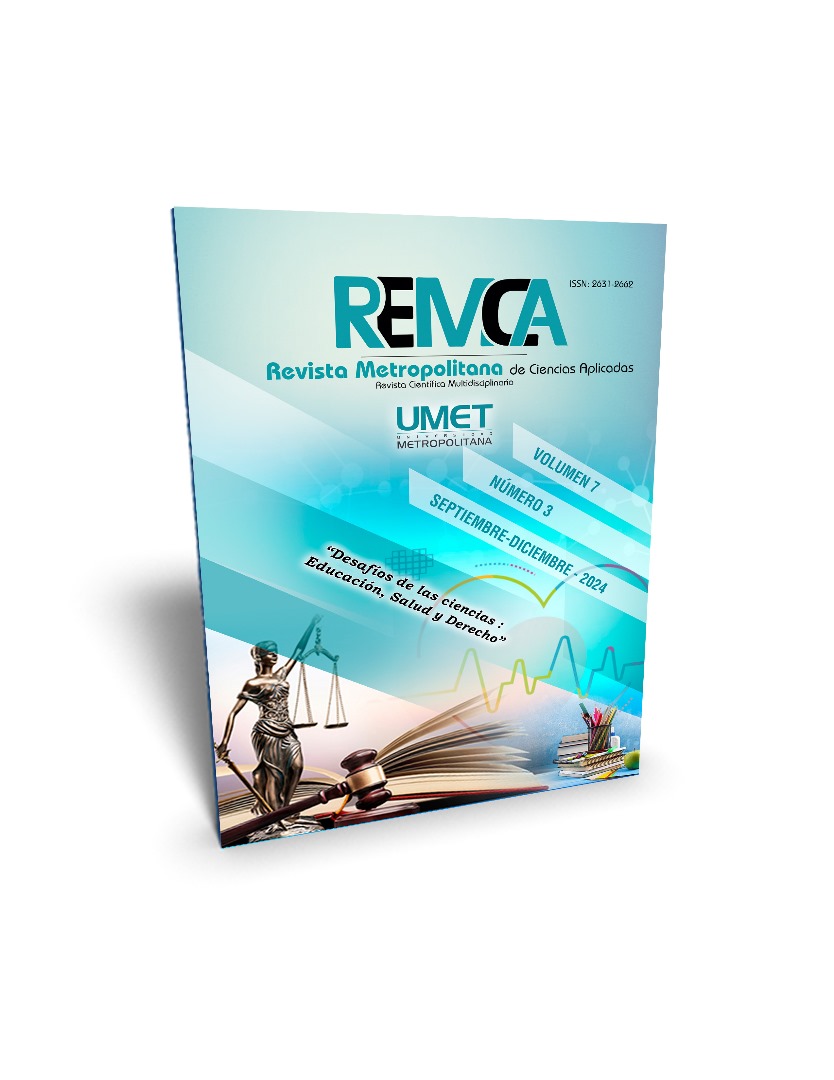La inclusión educativa. Precisiones teóricas y metodológicas para la atención a la diversidad de estudiantes en el currículo en la Educación Primaria
DOI:
https://doi.org/10.62452/6h9fje91Palabras clave:
Currículo, educación inclusiva, factores limitantes del docenteResumen
El presente artículo te da un breve acercamiento hacia los antecedente y concepción de la Educación Inclusiva como área formativa del currículo de la Nueva Escuela Mexicana, resaltando la influencia del papel docente en compromiso de direccionar el termino hacia los ambientes de aprendizajes armónicos y las practicas pedagógicas inclusivas, al asegurar por medio de su práctica, la participación de todos los niños/niñas y/o adolescente y en demanda de cubrir las atenciones requeridas de aquellos alumnos que presentan barreras en el aprendizaje. Reconociendo en él, algunos factores limitantes que obstaculicen implementar una educación inclusiva en el aula con respecto al trato que requieren alumnos con distintas necesidades educativas de índole especial o extraordinario, estos factores en docente de carácter actitudinal, de formación inicial, experiencias y actualización, determinaran su postura con respecto al nivel de apoyo brindado hacia la integración de los alumnos que cuentan con Necesidades Educativas Especiales y que se verán reflejado en el rendimiento académico del alumno.
Descargas
Referencias
Ainscow, M. (2001). Desarrollo de Sistemas Educativos Inclusivos. Ponencia a presentar en San Sebastián. https://sid-inico.usal.es/idocs/F8/FDO6565/mel_ainscow.pdf
Alcaraz, S., & Arnaiz, P. (2020). La escolarización del alumnado con necesidades educativas especiales en España: un estudio longitudinal. Revista Colombiana de Educación, 78, 299-320. http://doi.org/10.17227/rce.num78-10357
Barón, R., & Byrne, D. (2002). Psicología social. Prentice-Hall.
Calvo, G. (2015). La formación de docentes para la inclusión educativa. Teacher training for inclusive education. Páginas De Educación, 6(1), 19–35. https://doi.org/10.22235/pe.v6i1.525
Campoy, I (2007). La educación de los niños en el discurso de los derechos humanos. En, I. Campoy (Ed). Los derechos de los niños: perspectivas, jurídicas y ilosóicas, (pp.149-201). Dykinson.
Cárdenas Aguilar, T, J,. & Barraza Macías, A. (2014). Marco Conceptual y Experiencias de la Educación Especial en México. Instituto Universitario Anglo Español http://www.upd.edu.mx/PDF/Libros/MarcoConceptual.pdf
Casanova Rodríguez, M.A. (2011). De la educación especial a la inclusión educativa. Estado de la cuestión y retos pendientes. Participación Educativa, 18. https://autismomadrid.es/wp-content/uploads/2011/11/revista_casanova-1.pdf
Echeita Sarrionandia, G. (2017). Educación inclusiva. Sonrisas y lágrimas. Aula Abierta, 46(2), 17–24. https://doi.org/10.17811/rifie.46.2.2017.17-24
Echeita Sarrionandia, G. (2022). Gerardo Echeita: «Educación inclusiva es hablar de todo el alumnado y no únicamente de un determinado grupo de estudiantes». Tekman, https://www.tekmaneducation.com/echeita-educacion-inclusiva/
Flores Barrera, V. J., García Cedillo, I., & Romero Contreras, S, (2017). Prácticas inclusivas en la formación docente en México. Liberabit. Revista Peruana de Psicología, 23(1), 39-56. https://doi.org/10.24265/liberabit.2017.v23n1.03
Lema, C. (2009). El impacto en la educación de la Convención de la ONU sobre los derechos de las personas con discapacidad. En, M.A. Casanova y M.A. Cabra de Luna (Coords). Educación y personas con discapacidad. Presente y futuro. (pp. 31-65). Fundación ONCE
López González, M. (2015). La formación del maestro y la atención de las necesidades educativas especiales en una escuela para todos. Tendencias Pedagógicas, 3, 85–98. Recuperado a partir de https://revistas.uam.es/tendenciaspedagogicas/article/view/tp1997.3.ART05
López, M. (2014). La formación de los profesores y las dificultades de aprendizaje. Revista Nacional e Internacional de Educación Inclusiva, 7(2), 98-112. https://redined.educacion.gob.es/xmlui/bitstream/handle/11162/226302/L%C3%B3pez%20%282%29.pdf?sequence=1
México. Secretaría de Educación Pública. (2022). Plan de Estudios (2022). Plan de Estudio para la educación preescolar, primaria y secundaria. https://educacionbasica.sep.gob.mx/wp-content/uploads/2023/07/Plan_de_Estudios_para_la_Educacion_Preescolar_Primaria_y_Secundaria.pdf
México. Secretaría de Educación Pública. (2017). Programa para la Inclusión y la Equidad Educativa. Consistencia y Resultados. https://www.gob.mx/sep/documentos/programa-para-la-inclusion-y-la-equidad-educativa-2017-2018?state=published
Milicic, N., & López de Lérida, S. (2003). La Inclusión del niño con Necesidades Educativas Especiales: Algo más que un desafío pedagógico. Rev. Psicopedagogía, 20(62), 143-53 https://pepsic.bvsalud.org/pdf/psicoped/v20n62/v20n62a07.pdf
Mula Franco, A., Alaminos, A., Navas L., Torregosa Gironés, G., Sabroso Cetina, A., López-Cano Navarro, D., Mora Cañada, C., Sánchez Ezcurra, J.L., Panera García, I., & Santacreu, O. (2002). Incidencias de las actitudes y expectativas de alumnos y profesores sobre el desarrollo del programa de integración. Universidad de Alicante
Organización de las Naciones Unidas para la Educación, la Ciencia y la Cultura. (1990). Declaración Mundial sobre Educación para todos "Satisfacción de las Necesidades Básicas de Aprendizaje". UNESCO. https://unesdoc.unesco.org/ark:/48223/pf0000262438_spa
Organización de las Naciones Unidas para la Educación, la Ciencia y la Cultura. (1994). Declaración de Salamanca y Marco de Acción sobre Necesidades Educativas Especiales. Conferencia Mundial sobre Necesidades Educativas Especiales: Acceso y Calidad. UNESCO. https://unesdoc.unesco.org/ark:/48223/pf0000098427_spa
Organización de las Naciones Unidas para la Educación, la Ciencia y la Cultura. (1997). Declaración en el día mundial de la discapacidad. UNESCO. https://www.unesco.cl/necesidades-educativas-especiales/
Organización de las Naciones Unidas para la Educación, la Ciencia y la Cultura. (2016). Educación 2030. Declaración de Incheon. Hacia una educación inclusiva, equitativa y de calidad y un aprendizaje a lo largo de la vida para todos. UNESCO. https://unesdoc.unesco.org/ark:/48223/pf0000245656_spa
Organización de las Naciones Unidas para la Educación, la Ciencia y la Cultura. (2008). Conferencia Internacional de Educación. La Educación Inclusiva: El camino hacia el Futuro. https://unesdoc.unesco.org/ark:/48223/pf0000162787_spa
Descargas
Publicado
Número
Sección
Licencia
Derechos de autor 2024 Revista Metropolitana de Ciencias Aplicadas

Esta obra está bajo una licencia internacional Creative Commons Atribución-NoComercial-CompartirIgual 4.0.
© Podrá reproducirse, de forma parcial o total, el contenido de esta publicación, siempre que se haga de forma literal y se mencione la fuente.


